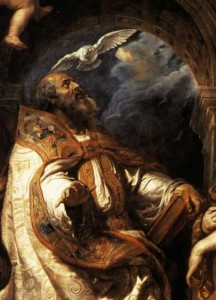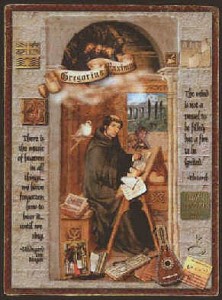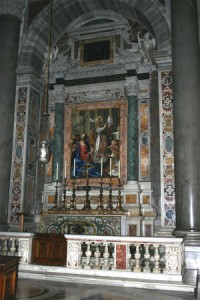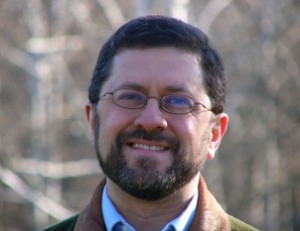We talk with Mike Aquilina about St. Gregor the Great, a father of the Church.
Podcast: Play in new window | Download (20.0MB) | Embed
Subscribe: Apple Podcasts | Spotify | Amazon Music | Android | Pandora | iHeartRadio | JioSaavn | Podchaser | Gaana | Podcast Index | Email | TuneIn | Deezer | Anghami | RSS | More
 St. Gregory the Great…the tradition of the Church considers him one of the four great doctors of the Latin Church. Born in Rome, Italy, in AD 540, St. Gregory was the son of Gordianus, a wealthy senator, and Silvia, who later became a saint. (Saints make saints after all…).
St. Gregory the Great…the tradition of the Church considers him one of the four great doctors of the Latin Church. Born in Rome, Italy, in AD 540, St. Gregory was the son of Gordianus, a wealthy senator, and Silvia, who later became a saint. (Saints make saints after all…).
His youth was a troubled one. In his writings he chronicles the perpetual seiges that Rome endured at the hands of the barbarians. Those nasty Lombards! Pillaging, raping, massacring, they would plague the Church and the people of the land for 200 years, you name it..by any standard, they were bad!
Saint Gregory became the Prefect of Rome at the age of thirty, and the people loved him because he was able to keep them safe. A few years later, like his parents, he gave his wealth away. He became a Benedictine monk. But the pope of the time, recalled him to Rome to serve as a deacon and to help the city, which was again attacked by the Lombards.
On the third day of September in 590, after he had first been ordained a priest, Saint Gregory was consecrated Pope and Bishop of Rome, in Saint Peter’s Basilica. He was the first monk to become Pope. The Holy Spirit didn’t waste anytime moving him to service!
Through Saint Leander and his brother, Saint Isidore of Seville, as well as the martyr  Saint Hermenegild, Saint Gregory recovered Spain from the Arians. Through Queen Theodelinda, the wife of the Lombard King Agilulf, he was able to begin the conversion of the Lombard nation and the tempering of their ferocious and cruel natures. He won France back and began conversions in England. Saint Gregory was, above all else, a vigilant guardian of the Church’s doctrine, always the mark of a holy Pope. He ordained, early in his pontificate that the first four Ecumenical Councils of the Church should be treated with the respect given to the four Gospels. He worked unceasingly to stamp out heresy. He ordered that at the beginning of Lent the blessed ashes should be placed on the foreheads of the faithful, instead of only the head of the Pope — as had been the custom up to that time — and that the priest should repeat to each one, “Remember man, that dust thou art, and unto dust thou shalt return”. excerpted in part from an article by Sister Catherine Goddard Clark, M.I.C.M.
Saint Hermenegild, Saint Gregory recovered Spain from the Arians. Through Queen Theodelinda, the wife of the Lombard King Agilulf, he was able to begin the conversion of the Lombard nation and the tempering of their ferocious and cruel natures. He won France back and began conversions in England. Saint Gregory was, above all else, a vigilant guardian of the Church’s doctrine, always the mark of a holy Pope. He ordained, early in his pontificate that the first four Ecumenical Councils of the Church should be treated with the respect given to the four Gospels. He worked unceasingly to stamp out heresy. He ordered that at the beginning of Lent the blessed ashes should be placed on the foreheads of the faithful, instead of only the head of the Pope — as had been the custom up to that time — and that the priest should repeat to each one, “Remember man, that dust thou art, and unto dust thou shalt return”. excerpted in part from an article by Sister Catherine Goddard Clark, M.I.C.M.
He is known for his magnificent contributions to the Liturgy of the Mass and Office. The “Gregorian Chant” is named in honor of Saint Gregory’s patient labor in restoring the ancient chant of the Church and in setting down the rules to be followed so that Church music might more perfectly fulfill its function.
Saint Gregory the Great died on the twelfth of March, 604, at the age of sixty-four. He was canonized immediately after his death. Later, because of the volume, the extraordinary insight and the profundity of his writings, the depth and extent of his learning, and the heroic holiness of his life, the Church gratefully placed him beside Jerome and Ambrose and Augustine. Saint Gregory the Great became the fourth of the Church’s four great Doctors of the West. –
What would today be like without a little Gregorian Chant in honor of our St. Gregory?
Spiritual Writings:
– Pastoral Rule
– Register of Letters
 The altar of St. Gregory the Great at St. Peter’s in Rome. One of my favorite places to pray at the Vatican.
The altar of St. Gregory the Great at St. Peter’s in Rome. One of my favorite places to pray at the Vatican.


